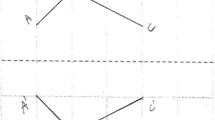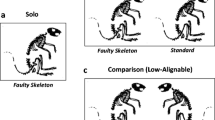Abstract
This study is focused on identifying and describing the reasoning patterns of middle grade students when examining potentially similar figures. Described here is a framework that includes 11 strategies that students used during clinical interview to differentiate similar and non-similar figures. Two factors were found to influence the strategies students selected: the complexity of the figures being compared and the type of distortion present in nonsimilar pairings. Data from this study support the theory that distortions are identified as a dominant property of figures and that students use the presence and absence of distortion to visually decide if two figures are similar. Furthermore, this study shows that visual reasoning is not as primitive or nonconstructive as represented in earlier literature and supports students who are developing numeric reasoning strategies. This illuminates possible pathways students may take when advancing from using visual and additive reasoning strategies to using multiplicative proportional reasoning on similarity tasks. In particular, distortion detection is a visual activity that enables students to reflect upon and evaluate the validity and accuracy of differentiation and quantify perceived relationships leading to ratio. This study has implications for curriculum developers as well as future research.










Similar content being viewed by others
References
Chazan, D. I. (1987). Similarity: Unraveling a conceptual knot with the aid of technology. In Proceedings of the Eleventh International Conference of the Psychology of Mathematics Education (pp. 3–9). Montreal: PME
Cox, D. C. (2008). Understanding similarity: bridging numeric and geometric contexts for proportional reasoning.Unpublished Dissertation, Kalamazoo, Michigan: Western Michigan University.
Cox, D. C. (2013). Similarity in middle school mathematics: at the crossroads of geometry and number. Mathematical Thinking and Learning, 15(1), 3–23.
Cox, D. C., Lo, J.-J., & Mingus, T. (2007). Low achieving middle school students' conceptions of same shape. In Proceedings of the 29th annual meeting of the North American Chapter of Psychology of Mathematics Education (pp. 130–132). Stateline: University of Nevada, Reno.
Cramer, K. A., & Post, T. (1993). Making connections: A case for proportionality. Arithmetic Teacher, 40(6), 342–346.
Fassnacht, C., & Woods, D. (2005). Transana v2.0x. Madison: The Board of Regents of the University of Wisconsin System.
Geeslin, W. E., & Shar, A. O. (1979). An alternative model describing children's spatial preferences. Journal for Research in Mathematics Education, 10(1), 57–68.
Hart, K. M. (1988). Ratio and proportion. In J. Hiebert & M. J. Behr (Eds.), Number concepts and operations in the middle grades (pp. 198–219). Reston: National Council of Teachers of Mathematics & Lawrence Erlbaum Associates.
Hatch, J. A. (2002). Doing qualitative research in education settings. Albany: State University of New York Press.
Kaput, J. J., & West, M. (1994). Missing-value proportional reasoning problems: Factors affecting informal reasoning patterns. The development of multiplicative reasoning in the learning of mathematics (pp. 235–287). Albany: State University of New York Press.
Lamon, S. J. (1993). Ratio and proportion: Connecting content and children's thinking. Journal for Research in Mathematics Education, 24(1), 41–61.
Lamon, S. J. (2007). Rational numbers and proportional reasoning: Toward a theoretical framework for research. In F. K. Lester (Ed.), Second handbook of research on mathematics teaching and learning, 1 (pp. 629–667). Charlotte: Information Age.
Lehrer, R., Strom, D., & Confrey, J. (2002). Grounding metaphors and inscriptional resonance: Children's emerging understanding of mathematical similarity. Cognition and Instruction, 20(3), 359–398.
Piaget, J. (1966). The child's conception of space. London: Routledge.
Piaget, J., Inhelder, B., & Szeminska, A. (1960). Child's conception of geometry. London: Routledge and Kegan Paul.
Swoboda, E., & Tocki, J. (2002). How to prepare prospective teachers to teach mathematics—Some remarks. Second International Conference on the Teaching of Mathematics (at the Undergraduate Level), Crete, Greece.
Tall, D., & Vinner, S. (1981). Concept image and concept definition in mathematics with particular reference to limits and continuity. Educational Studies in Mathematics, 12(2), 151–169.
Van den Brink, J., & Streefland, L. (1979). Young children (6–8)—Ratio and proportion. Educational Studies in Mathematics, 10(4), 403–420.
van Hiele, P. M. (1986). Structure and insight: A theory of mathematics education. Orlando: Academic.
Acknowledgments
This work was supported by Center for the Study of Mathematics Curriculum under NSF award #ESI-0333879. The authors would like to acknowledge the teachers and students at Cityscape Middle School for their willingness to share their classrooms and ideas. Portions of this work were presented at the 2010 Annual Meeting of the North American Chapter of the Psychology of Mathematics Education.
Author information
Authors and Affiliations
Corresponding author
Rights and permissions
About this article
Cite this article
Cox, D.C., Lo, JJ. Detecting distortion: bridging visual and quantitative reasoning on similarity tasks. Math Ed Res J 26, 1–23 (2014). https://doi.org/10.1007/s13394-013-0108-1
Received:
Revised:
Accepted:
Published:
Issue Date:
DOI: https://doi.org/10.1007/s13394-013-0108-1




